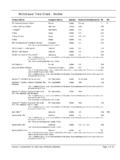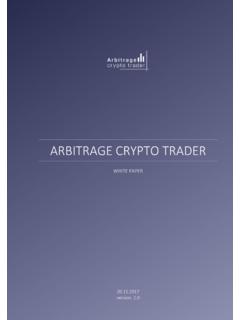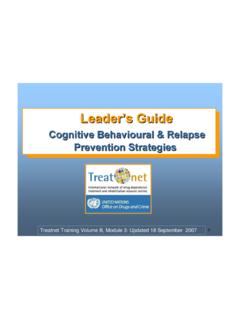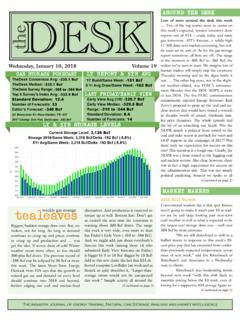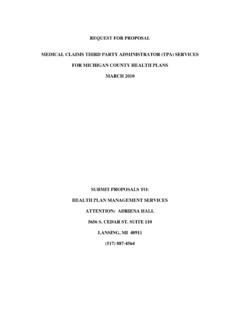Transcription of OFFSHORE TECHNOLOGY REPORT 2001/010
1 HSEH ealth & SafetyExecutiveEnvironmental considerationsOFFSHORE TECHNOLOGY REPORT2001/010 HSEH ealth & SafetyExecutiveEnvironmental considerationsEdited under the HSE Technical Support Agreement by BOMEL LtdLedger HouseForest Green RoadFifieldMaidenheadBerkshire SL6 2 NRHSE BOOKSii Crown copyright 2002 Applications for reproduction should be made in writing to:Copyright Unit, Her Majesty s Stationery Office,St Clements House, 2-16 Colegate, Norwich NR3 1 BQFirst published 2002 ISBN 0 7176 2379 3 All rights reserved. No part of this publication may bereproduced, stored in a retrieval system, or transmittedin any form or by any means (electronic, mechanical,photocopying, recording or otherwise) without the priorwritten permission of the copyright REPORT is made available by the Health and SafetyExecutive as part of a series of reports of work which hasbeen supported by funds provided by the the Executive.
2 Nor the contractors concernedassume any liability for the reports nor do theynecessarily reflect the views or policy of the CONTENTS Page No FOREWORD v 1 INTRODUCTION AND SCOPE 1 Source of Information 1 Considerations 1 Return Periods of Parameter Values 1 Site-Specific and Indicative Design Parameters 2 Further Information 3 Definitions 3 2 THE PARAMETERS 9 3 WINDS 11 Introduction 11 Site-Specific Measurements (Winds) 12 Indicative Values (Winds) 13 4 WAVES 19 Introduction 19 Site-Specific Measurements (Waves) 22 Indicative Values (Waves) 25 Shallow Water Effects 27 Seasonal Variations (Waves) 28 5 WATER DEPTHS AND SEA LEVEL VARIATIONS 29 Introduction 29 Site-Specific Measurements (Water Depths) 29 Indicative Values (Water Depths) 30 Long Term Changes (Water Depths) 35 Seasonal Variations (Water Depths) 35 6 CURRENTS 37 Introduction 37 Site-Specific Measurements (Currents) 38 Indicative Values (Currents) 38 Seasonal Variations (Currents) 46 Currents in Deep Waters 47 7 AIR AND SEA TEMPERATURES 49 Introduction 49 Site-Specific Measurements (Temperatures) 49 Indicative Values (Temperatures) 50 iv CONTENTS (Continued)
3 Page No 8 SNOW AND ICE 57 Introduction 57 Indicative Values (Snow and Ice) 57 9 MARINE GROWTHS 61 Introduction 61 Indicative Values (Marine Growths) 61 10 COMBINATIONS OF EXTREME PARAMETERS 63 Introduction 63 Extreme Surface Elevation 63 Extreme Fluid Velocity 64 Extreme Temperatures Combined With Extreme Wind Speed and Wave Height 65 Extreme Snow and Ice Combined with Extreme Wind Speed 65 11 METOCEAN PARAMETERS FOR FATIGUE CALCULATIONS 67 Introduction 67 Wave Parameters 67 Current Parameters 70 Wind Parameters 70 12 REFERENCES 71 v FOREWORD This document provides technical information previously contained in the Fourth Edition of the Health and Safety Executive s OFFSHORE Installations: Guidance on Design, Construction and Certification (1990 edition plus amendments)(1).
4 The Guidance was originally published in support of the certification regime under SI289, the OFFSHORE Installations (Construction and Survey) Regulations 1974(2). However, SI289 was revoked by the OFFSHORE Installations (Design and Construction, etc) Regulations, 1996, which also introduced the verification provisions into the OFFSHORE Installations (Safety Case) Regulations, 1992. The Guidance was formally withdrawn in its entirety on 30 June 1998 (see HSE OSD Operations Notice 27(3)). The withdrawal of the Guidance was not a reflection of the soundness (or otherwise) of the technical information it contained; some sections (or part of sections) of the Guidance are currently referred to by the OFFSHORE industry.
5 For this reason, after consultation with industry, relevant sections are now published as separate documents in the HSE OFFSHORE TECHNOLOGY (OT) REPORT series. It should be noted that the technical content of the Guidance has not been updated as part of the re-formatting for OTO publication, although prescriptive requirements and reference to the former regulatory regime have been removed. The user of this document must therefore assess the appropriateness and currency of the technical information for any specific application. Additionally, the user should be aware that published sections may cease to be applicable in time and should check with Operations Notice 27, which can be viewed at , for their current status.
6 Vi 1 1. INTRODUCTION AND SCOPE SOURCE OF INFORMATION This OFFSHORE TECHNOLOGY (OT) REPORT provides technical information on metocean parameters for OFFSHORE Installations in UK waters. It is based on guidance previously contained in Section 11 of the Fourth Edition of the Health and Safety Executive s OFFSHORE Installations : Guidance on Design, Construction and Certification (1) which was withdrawn in 1998. As discussed in the Foreword, whilst the text has been re-formatted for OFFSHORE TECHNOLOGY publication, the technical content has not been updated. The appropriateness and currency of the information contained in this document must therefore be assessed by the user for any specific application.
7 The information on environmental conditions presented in this document is supported by two background reports, OTH 89 299(4) and OTH 89 300(5). CONSIDERATIONS An accurate assessment of the meteorological and oceanographic environment is fundamental to the sound design of OFFSHORE installations. Only on this basis is it possible to calculate the loads likely to be imposed by natural phenomena and to predict the behaviour of structures under extreme loading conditions and prolonged exposure. Environmental forces are relatively more important in the design of OFFSHORE structures than with many other types of engineering structures. Metocean design parameters need to be established in the following areas: the speed and direction of winds and the effect of averaging period and height above the surface of the sea on their characteristics the heights, periods and directions of waves, the probability of their occurrence and the effect of currents, sea bed topography and other factors likely to modify their characteristics the water depth and variations in water level from tide and storm surge the speed and direction of tidal and other currents air and sea temperatures the extent of snow and ice accumulations the extent to which marine growth may form on the submerged sections of the installation.
8 The metocean parameters described in this document are relevant to the design of fixed, floating and compliant installations, but not necessarily to their tow-out to location, which will be the subject of special criteria developed for the particular operation. RETURN PERIODS OF PARAMETER VALUES Most metocean phenomena vary with time in a random manner, and extreme values to be used in design can only be chosen on a probabilistic basis. The probability that a metocean parameter will exceed a given value 2 leads to the concept of a return period (which is discussed in detail in OTH 89 299(4) and OTH 89 300(5)). The definition of return period adopted for this REPORT is: The return period of a stated value of a metocean variable is the average period of time between exceedances of that value.
9 The value with an N-year return period is commonly called the N-year return value of the variable. Extreme values given in this document are generally based on the 50-year return value, although formulae are given which enable extreme values with other return periods to be calculated. These values may be relevant to the determination of suitable combinations of individual metocean parameters, as discussed in Section 10. For mobile installations that are not on location throughout the year, it may be appropriate to establish 50- year return values of metocean parameters for the season of operation alone. It should be noted that where a structure or part of a structure is likely to respond dynamically to the forces on it, or for geometric reasons, metocean parameters with return periods shorter than 50 years may produce the extreme response from the structure.
10 In determining the structural performance under operating conditions of those parts of a compliant installation which are subject to wave loading, the maximum operating condition should be determined using environmental parameters which are not less than those likely to be exceeded, on average, once a month ( conditions exceeded 12 times a year). The fatigue performance of an installation is a function of the whole range of metocean variables, not just their extreme values. SITE-SPECIFIC AND INDICATIVE DESIGN PARAMETERS In general, the metocean climate varies from location to location. The most accurate design parameters are therefore derived from long data sets gathered at the intended location of an installation, site-specific data.










